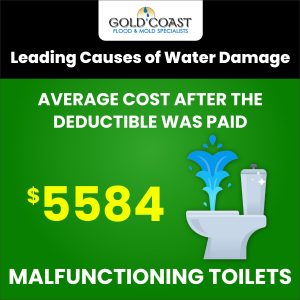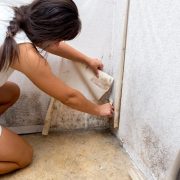Toilet Malfunction San Diego CA
The modern toilet is a marvel of contemporary engineering, often overlooked due to its ubiquitous presence in our lives. It’s a critical part of our daily routine and sanitation, but like any plumbing fixture, it can malfunction. When this happens, toilets not only become an inconvenience but also a potential cause of significant water damage.

8 Ways Your Toilet Can Cause Water Damage
There are several ways a toilet can malfunction, leading to water damage.
1. Overflowing Toilets
One of the most common issues is toilet overflow, often a result of a clog in the drain pipe. When the toilet is flushed in this state, water can’t flow down the pipe and instead spills onto the bathroom floor. The severity of the water damage depends on how quickly the issue is noticed and rectified. Left unnoticed, water can seep into the floor, causing significant structural damage over time.
2. Leaky Seals
Another common problem is a leaky base seal, also known as the wax ring. This ring seals the connection between the toilet and the floor flange. If the seal deteriorates or breaks, water can seep around the base of the toilet with every flush, unnoticed until signs of water damage appear. This can result in mold growth, floor damage, and if on an upper level, damage to the ceiling below.
3. Faulty Fill Valves
The fill valve, the component responsible for refilling the tank after each flush, can also malfunction. If it doesn’t shut off properly, the water will continue to flow into the overflow tube and eventually into the toilet bowl, causing it to constantly run or even overflow. This not only wastes a substantial amount of water but could lead to a water damage disaster if not addressed promptly.
4. Cracked Tank or Bowl
A cracked tank or bowl is a less common but equally serious issue. A crack can form due to impact, improper installation, or simple wear and tear over time. Depending on the size and location of the crack, it may cause a slow leak or a significant release of water, potentially flooding the bathroom and causing extensive damage.
5. Preventing Overflows with Flapper Valves
In some cases, a faulty flapper valve could cause the toilet to overflow. The flapper creates a seal within the tank and is lifted when the toilet is flushed, allowing water to enter the bowl. If the flapper is damaged or worn out, it may not seal properly, causing the toilet to run continuously and possibly overflow. Regularly check the condition of the flapper and replace it as needed to prevent this issue.
6. Understanding the Role of Water Supply Lines
The water supply line is another component that can lead to a toilet malfunction. This flexible pipe connects the household water supply to your toilet’s tank. Over time, wear and tear can cause the supply line to leak or burst. A burst supply line can release a large volume of water very quickly, causing immediate and extensive water damage. It’s crucial to replace supply lines as soon as you notice any signs of wear, such as fraying or visible corrosion at the connection points.
7. Dealing with Cold Temperatures
For those living in cold climates, frozen pipes present another risk. The water in your pipes can freeze when temperatures plummet, causing the pipe to burst. If the pipe leading to your toilet bursts, it can result in a major flood and significant water damage. Proper insulation and maintaining a warm indoor temperature can help prevent frozen pipes.
8. The Hidden Risk of High Water Pressure
High water pressure is another often overlooked issue that can lead to toilet malfunction. If the water pressure in your home is too high, it can damage the fill valve and other components in your toilet, leading to leaks. Over time, these leaks can cause water damage. Consider installing a pressure-reducing valve to regulate water pressure and avoid such issues.

Prevent a Toilet Malfunction with Proper Maintenance
Preventing water damage from toilet malfunctions is primarily about regular maintenance and prompt attention to any issues. General wear and tear can cause a variety of toilet malfunctions over time.
To keep your toilet in good working order and prevent water damage, it’s important to maintain and care for it regularly. Avoid using harsh, abrasive cleaners that could damage the toilet’s surfaces and seals. Also, never use the toilet as a trash bin. Flushing non-dissolvable items can lead to serious clogs and subsequent overflows.
1. Regular Inspection
Conduct regular inspections of your toilet. Look for visible cracks in the tank and bowl, water on the floor around the base, or a toilet that rocks when you sit on it, which might indicate a faulty seal.
2. Prompt Repairs
Do not ignore minor issues. If your toilet runs incessantly, overflows, or shows signs of a leak, it’s crucial to address these problems promptly. Some issues can be fixed with a DIY approach, like a simple clog, but more complex problems may require professional assistance.
3. Quality Parts
Invest in quality parts when replacing components of your toilet. This includes the fill valve, wax ring, and other internal mechanisms. While cheaper options may be tempting, higher-quality parts tend to last longer and are less likely to fail.
4. Professional Installation
Ensure professional installation if you’re not confident about doing it yourself. A poorly installed toilet can lead to many of the problems mentioned above.
Dealing with Water Damage
In the unfortunate event of water damage due to a toilet malfunction, it’s important to act fast. The first step is to stop the source of the water – this may involve shutting off the water supply at the valve located typically behind the toilet. Then, mop up and dry out the area as quickly as possible to mitigate damage. For significant water damage, professional water damage restoration services may be necessary to properly dry, sanitize, and repair the affected area.
Call Gold Coast Flood Restorations
To sum it up, while the humble toilet is a vital and generally reliable component of our homes, it’s not immune to problems. Regular inspections, prompt repairs, and understanding potential issues can prevent malfunctions and save you from the costly and inconvenient aftermath of water damage.










Also find us on…